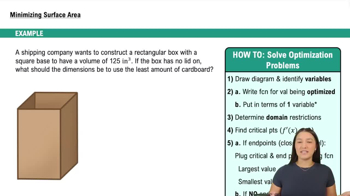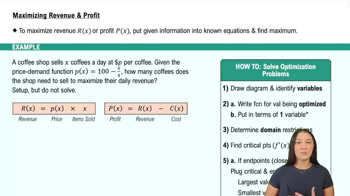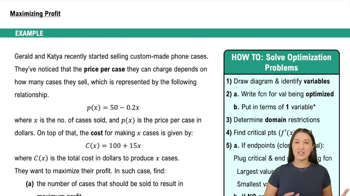Table of contents
- 0. Functions7h 52m
- Introduction to Functions16m
- Piecewise Functions10m
- Properties of Functions9m
- Common Functions1h 8m
- Transformations5m
- Combining Functions27m
- Exponent rules32m
- Exponential Functions28m
- Logarithmic Functions24m
- Properties of Logarithms34m
- Exponential & Logarithmic Equations35m
- Introduction to Trigonometric Functions38m
- Graphs of Trigonometric Functions44m
- Trigonometric Identities47m
- Inverse Trigonometric Functions48m
- 1. Limits and Continuity2h 2m
- 2. Intro to Derivatives1h 33m
- 3. Techniques of Differentiation3h 18m
- 4. Applications of Derivatives2h 38m
- 5. Graphical Applications of Derivatives6h 2m
- 6. Derivatives of Inverse, Exponential, & Logarithmic Functions2h 37m
- 7. Antiderivatives & Indefinite Integrals1h 26m
- 8. Definite Integrals3h 25m
5. Graphical Applications of Derivatives
Applied Optimization
Problem 4.5.21
Textbook Question
Shipping crates A square-based, box-shaped shipping crate is designed to have a volume of 16 ft³. The material used to make the base costs twice as much (per square foot) as the material in the sides, and the material used to make the top costs half as much (per square foot) as the material in the sides. What are the dimensions of the crate that minimize the cost of materials?
 Verified step by step guidance
Verified step by step guidance1
Let the side length of the base be x ft and the height of the crate be h ft. The volume of the crate is given by the equation V = x²h, and we know V = 16 ft³, so we can express h in terms of x: h = 16/x².
Next, determine the cost of materials. The area of the base is x², the area of the sides is 4xh, and the area of the top is x². Let the cost per square foot of the sides be C. Then, the cost of the base is 2C * x², the cost of the sides is C * 4xh, and the cost of the top is (1/2)C * x².
Combine the costs to form a total cost function: C_total = 2C * x² + C * 4xh + (1/2)C * x². Substitute h = 16/x² into this cost function to express it solely in terms of x.
Simplify the total cost function to find C_total as a function of x: C_total = (5/2)C * x² + (64C/x).
To minimize the cost, take the derivative of the cost function with respect to x, set the derivative equal to zero, and solve for x to find the critical points.
Recommended similar problem, with video answer:
 Verified Solution
Verified SolutionThis video solution was recommended by our tutors as helpful for the problem above
Video duration:
8mPlay a video:
Was this helpful?

 1:13m
1:13mWatch next
Master Intro to Applied Optimization: Maximizing Area with a bite sized video explanation from Callie
Start learningRelated Videos
Related Practice









